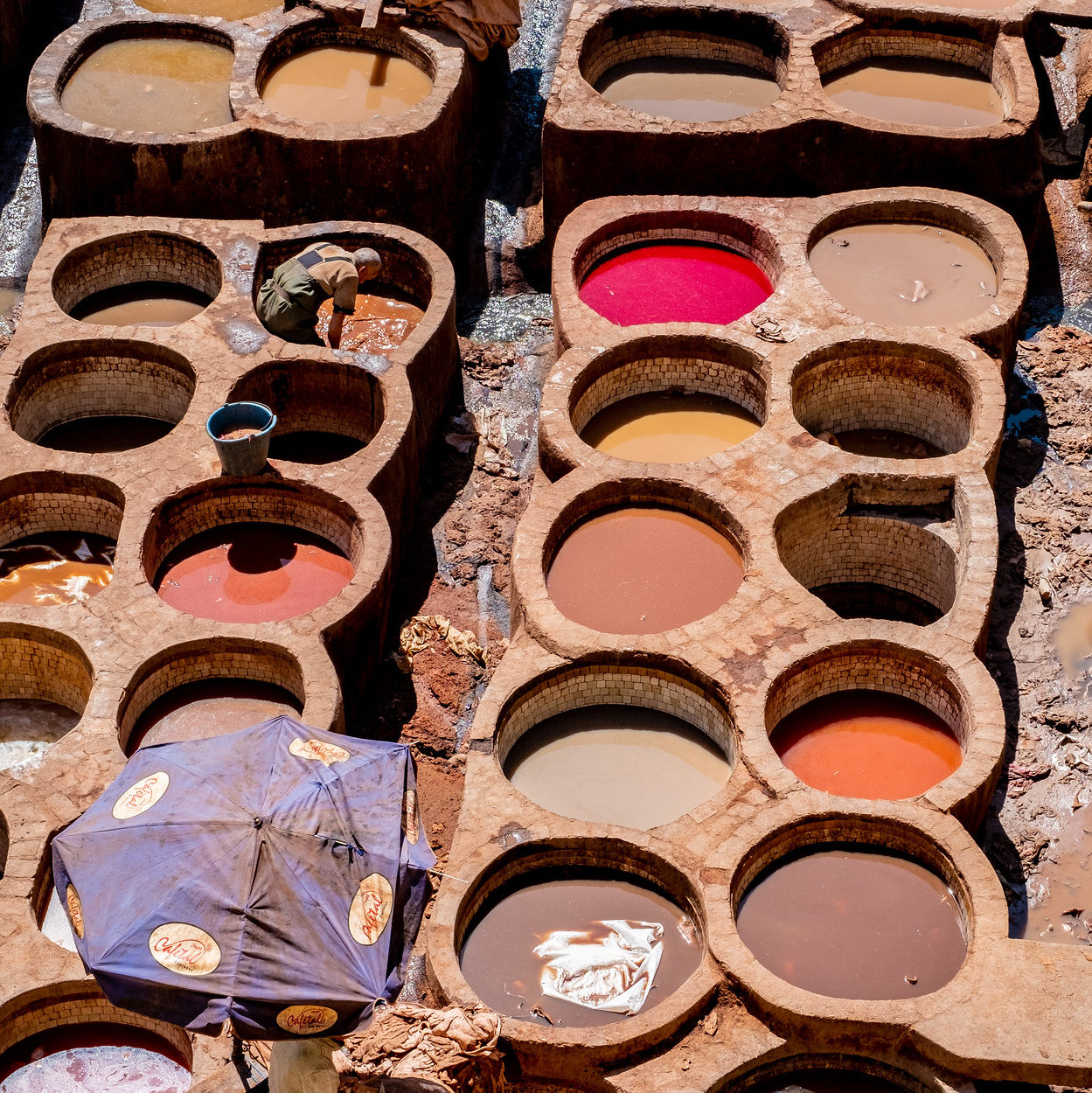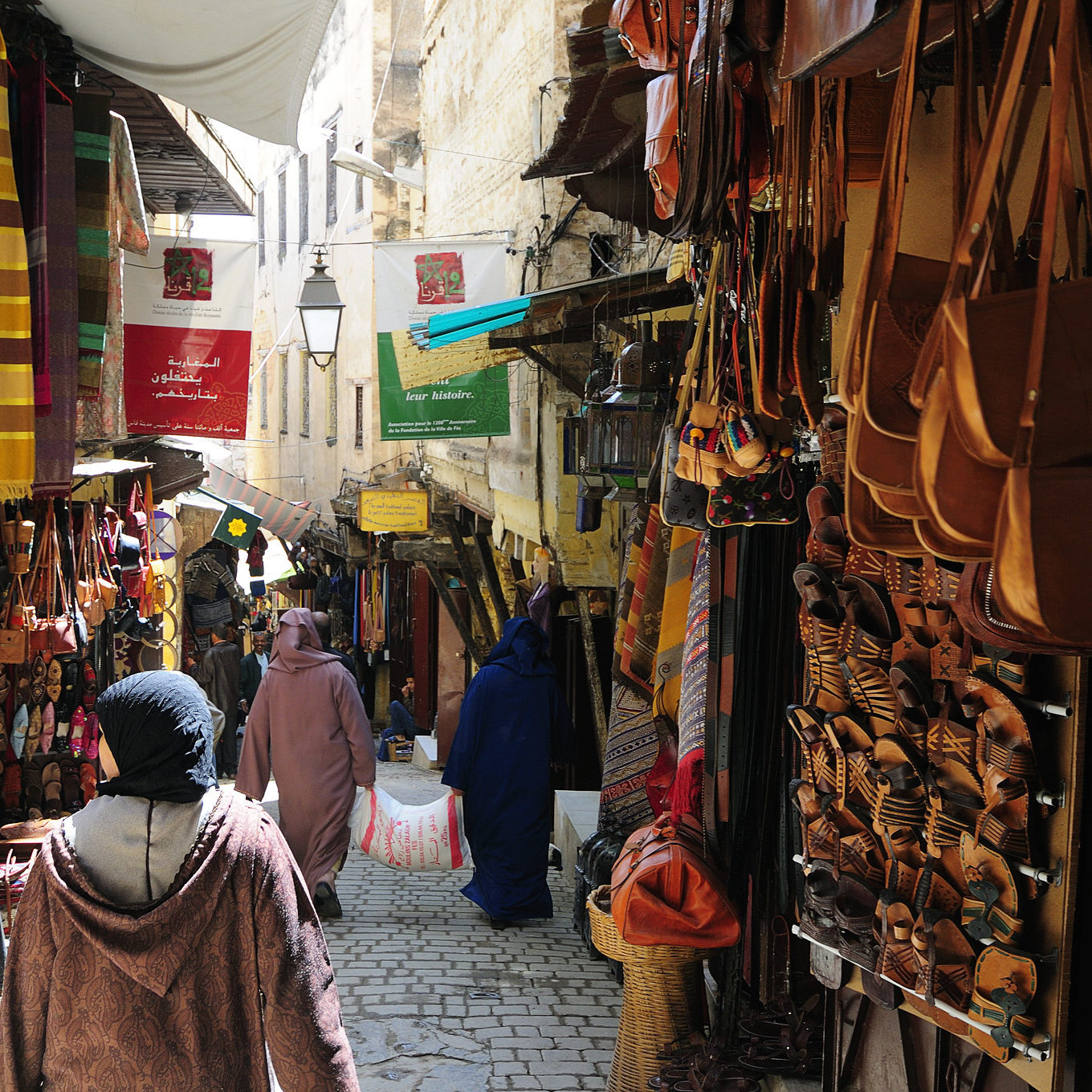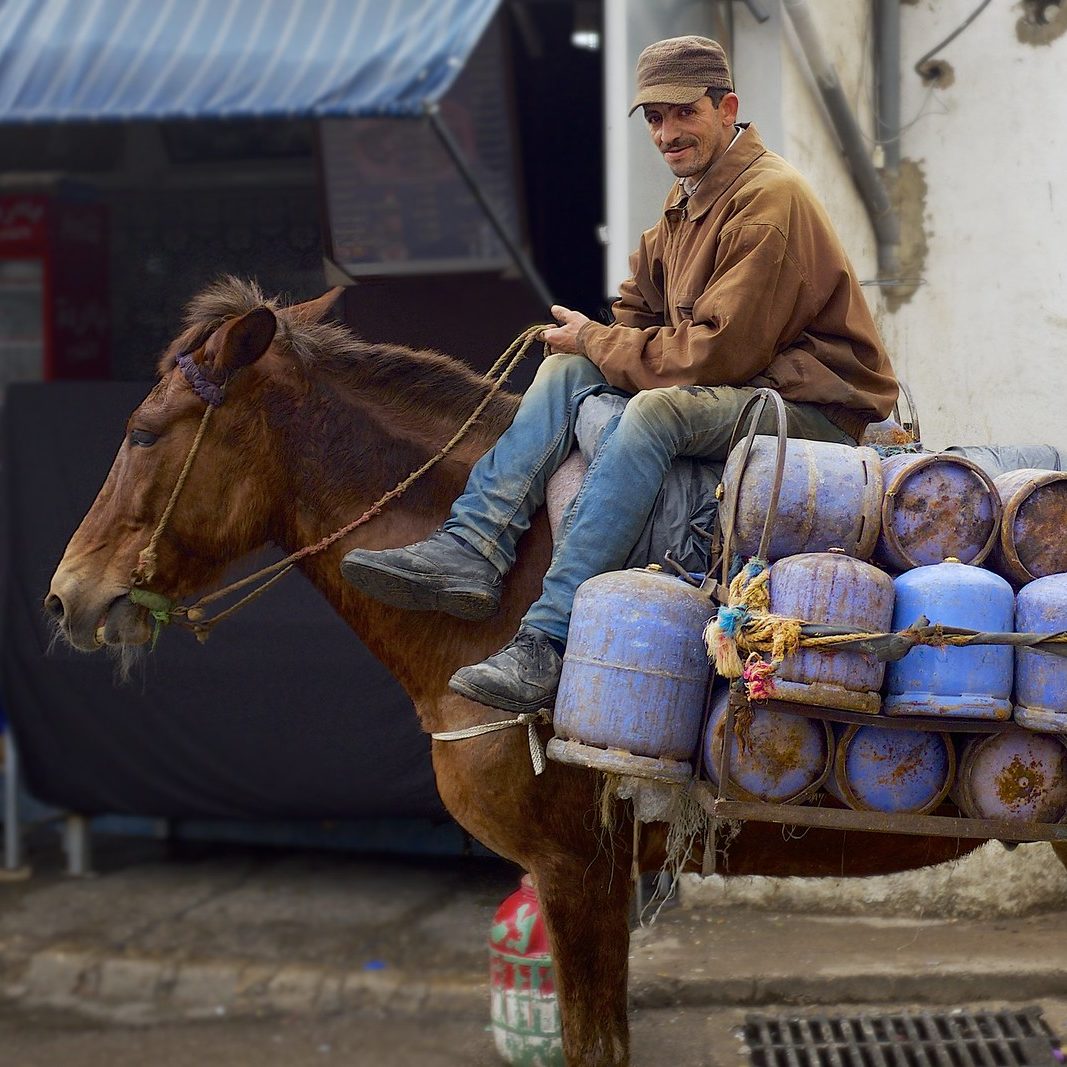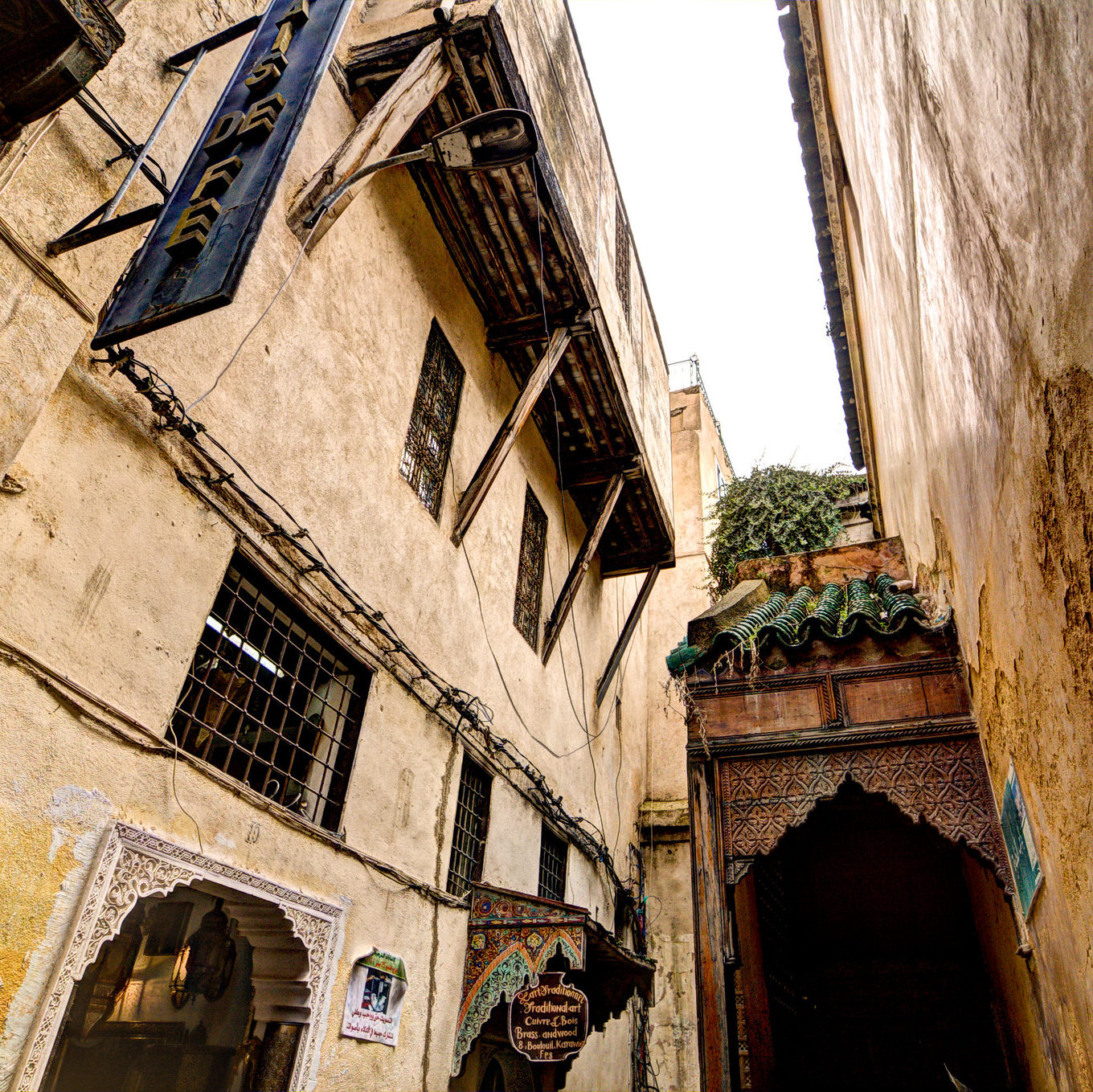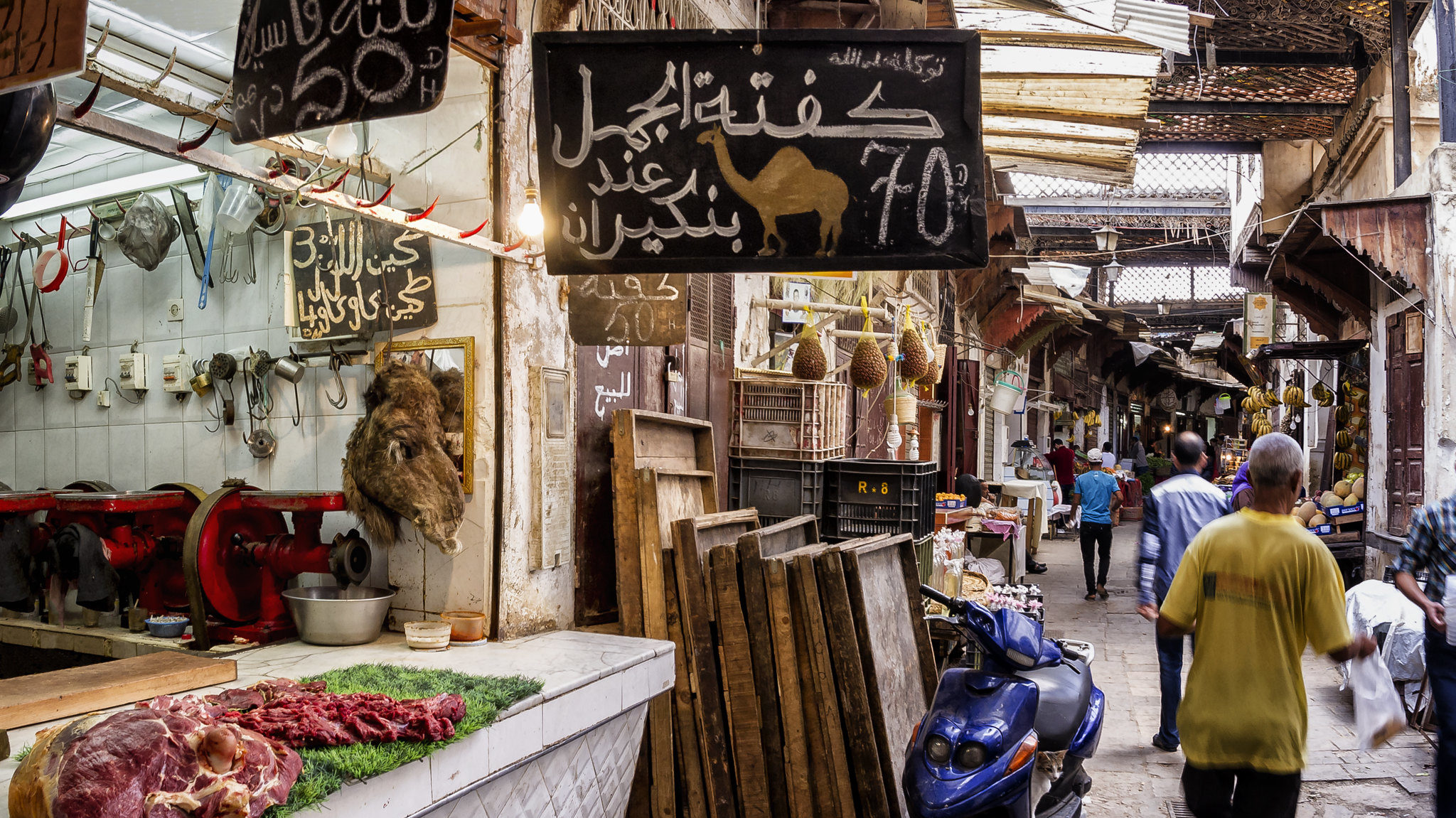
Getting lost in the medieval medina of Fez is both intimidating and enchanting. The city between the Rif and Middle Atlas is one that most see in a day, but that could hold secrets for a hundred. When you cross its ornate city gate, the maze unfurling before you is so vast that it’s legitimate to ask yourself if you can wander through the medina on your own. While it is possible, there are a few tricks you need to know. Read more to discover the secrets to exploring the Fez medina.
Fez el-Bali vs Fes el-Jdid Vs Nouvelle Ville
Fes el-Bali: Being the oldest district of Fez, the earthy medina of Fes el-Bali counts around 9000 streets packed with fondouks, hammams and ancient mosques.
Fes el-Jdid: “New Fez” is the second half of this UNESCO world heritage site. A lot smaller than Fes el-Bali, its most interesting attractions are the Mellah (the Jewish quarter) and the imposing Royal Palace.
Nouvelle Ville: The “New City” is the newest part of Fez. It was created under French protectionism. This is where you can find the most modern restaurants and hotels.
Highlights of the medina
Chouara Tannery
Surrounded on all four sides like a fortress, the colorful Chouara Tannery is an open-air museum. From 8 AM to 7 PM, the workers dance around the chromatic vats and practice the ancient art of leather making. Far from a tourist trap, the tannery is one of the best views in the medina but is better enjoyed with a sprig of mint to cover up the foul smell of the dyes.
You don’t need a guide to see the tannery. You can technically enter the shops surrounding it for free. The truth is shopkeepers still expect you to buy something or, at least, to leave a tip. For an up-close look at the leather-making process, you can pay to go down to the vats, as this blogger did.
Ain Azliten and Sidi Moussa Tanneries
The Chouara Tannery is not the only one in the city of Fez. If time permits, it’s definitely to pay a visit to the others.
The Sidi Moussa Tannery can be found southwest of the Zawiya of Moulay Idris II.
The Ain Azliten Tannery is hidden away in the north of the medina.
Bab Bou Jeloud
Restaurated in 1913, the portal of the old medina is a modern icon of the city. The blue tilework of the exterior brings to the fore this true time portal. The view of the nearby souk, with the restaurants humming nearby and the two minarets in the distance, makes for a great picture, that’s for sure. Learn to recognize the inner green side of the Bab Bou Jeloud, as the adjacent plaza is a typical meeting point if you plan on doing tours.
Bou Inania Madrasa
Be careful when stepping into the marble courtyard of the Bou Inania Madrasa, because the elegance of its green tiles and majestic central patio might catch you off balance. The intricate patterns of wooden doors and mosaic-clad pillars give the place a serenity that is only fitting for a theological school such as this one. It is also not to be confused with its namesake in Meknes.
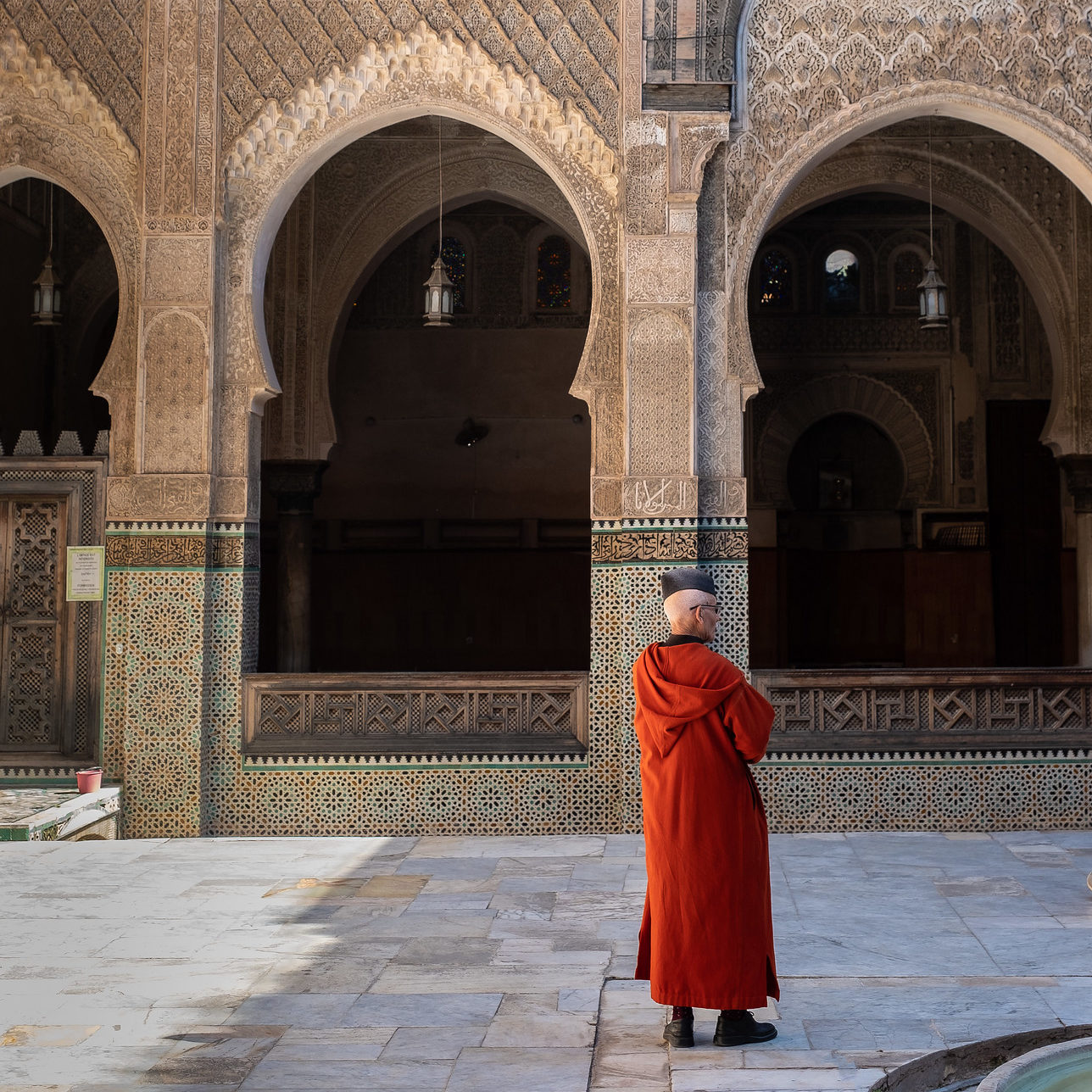
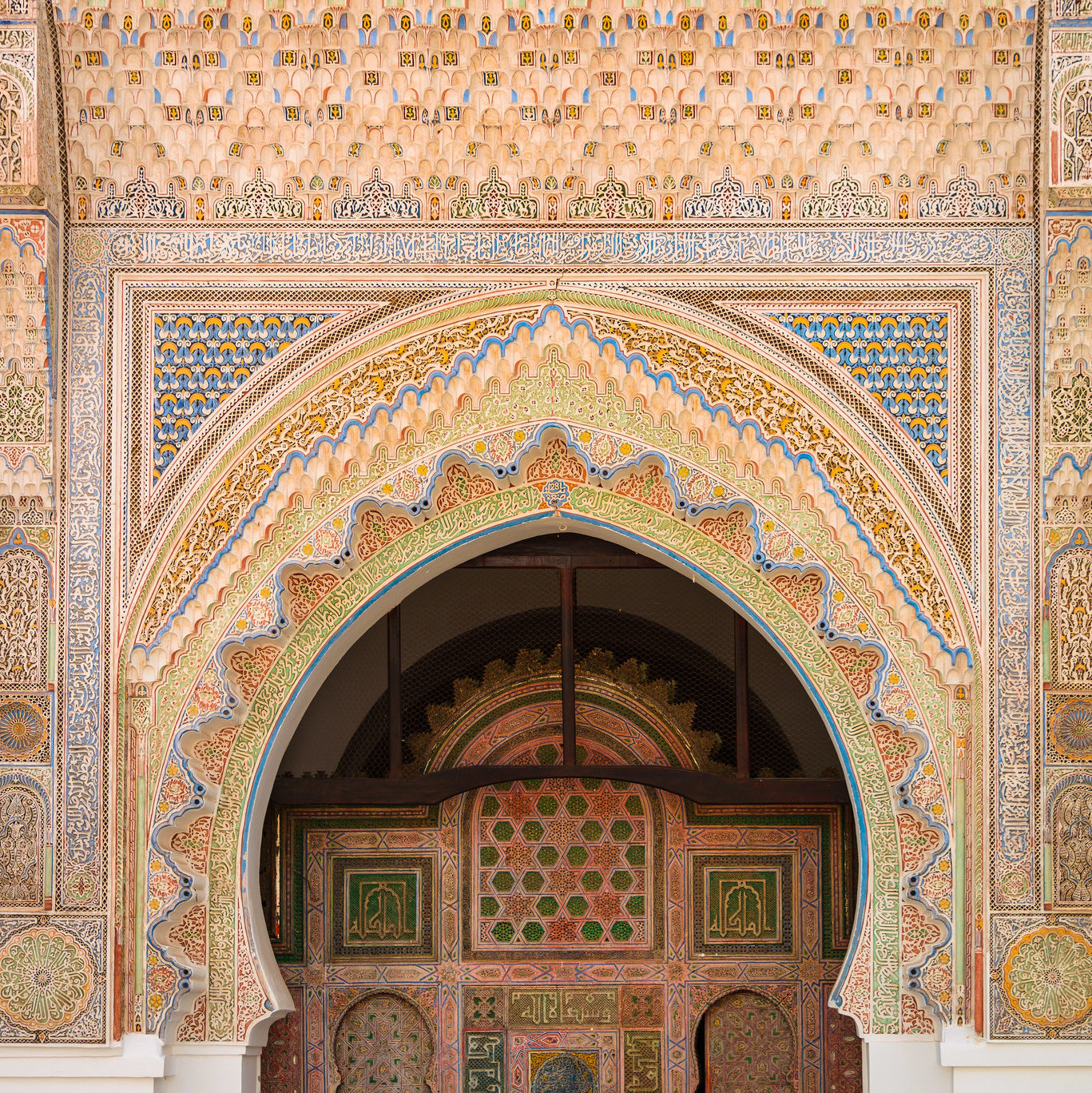
Al-Attarine Madrasa
Found only by stepping father into the medina, this second madrasa is not to be missed. Its small courtyard and dense motifs assuredly impart a sense of grandeur to the building. A real gem of Moorish architecture, it is one the finest example of the style accessible to non-Muslims in the country.
Other madrasas in Fez
Although there are a few other madrasas inside the medina, Bou Inania Madrasa and Al-Attarine Madrasa are the ones you should prioritize. The other madrasas of Fez haven’t been the subject of the same restorations that brought back the glory of those two.
Souks
The fascinating haggle-filled street markets have something enticing. But their secrets can only be unveiled after spending some time in the medina. Brimming with souks, Fez has one to fulfil your every need; you only need to name it. Souk el Henna is the oldest of the imperial city and is renowned for the cosmetics it sells. The best food is sold in Boujloud Souk and, on the other side of town, at R’cif Square. The colorful spice stalls of Souk Al-Attarine distinguish it as the best place to find a vibrant setting for great travel pictures. For souvenir shopping, you’ll find what you need at Souk Mejjadliene (traditional belts), Souk Serrajine (Moroccan slippers), and Souk Tillisse (handmade rugs). Finally, the finest leather is found at Souk Jeld. Knowing this, make sure to leave some space in your luggage for the extra souvenirs!
Jnan Sbil Gardens
The small gardens between Fes el-Jdid and Fes el Bali offer a deserved respite after the frenzy of the medina. Beautifully landscaped with fountains and palm trees, the Jnan Sbil Gardens will feel like a breath of fresh air. The park is perfect for an afternoon stroll or sitting in the sun and enjoying the delightful smell of the blooming orange trees. Plus, you might see some colorful feathers as the gardens have a successful peacock breeding program. Just bear in mind the place is closed on Mondays.
Al-Qarawiyyin University and Mosque
As for all mosques in Morocco, the tile’s delicate contrasts of colour can only be seen up close if you are Muslim. Non-Muslims can still admire the green and white beauty of the oldest university in the world but only from the doorway. The best chance to glimpse the fountain and courtyard is when the doors open before and after the prayers.
Other places of interest inside Fes el-Bali
- Dar Batha Museum : An ancient Moorish palace turned museum with a nice collection of traditional Moroccan arts
- Fondouk el-Nejjarine : An old caravanserai converted into a museum where the wooden crafts of Fez are the centerpieces
- Chrabliyine Mosque : A small mosque worth seeing just for the beauty of its tricolor minaret
- Dar al-Magana : A mysterious relic of the past, the secret of how the Magana hydraulic clock functioned died with its creator.
- Zawiya of Moulay Idriss II: The tomb of Idris II, the man considered the principal founder of the city of Fez. Non-Muslims cannot enter but can peer inside.
- Palais Glaoui: The dilapidated palace gives an impactful look at modern Morocco and the difficulties of preserving history without funds.
Must-sees outside the medina of Fes el-Bali
- Borj Nord: Old fort housing weapons museum, especially recommended to aficionados of weaponry through the ages.
- Merenid Tombs: These ruins are located in a hill, from where you can see probably the best views of the old city of Fez
- The Royal Palace: The palace’s ornate and intricate detail is a sight to behold and a place to take some stunning pictures.
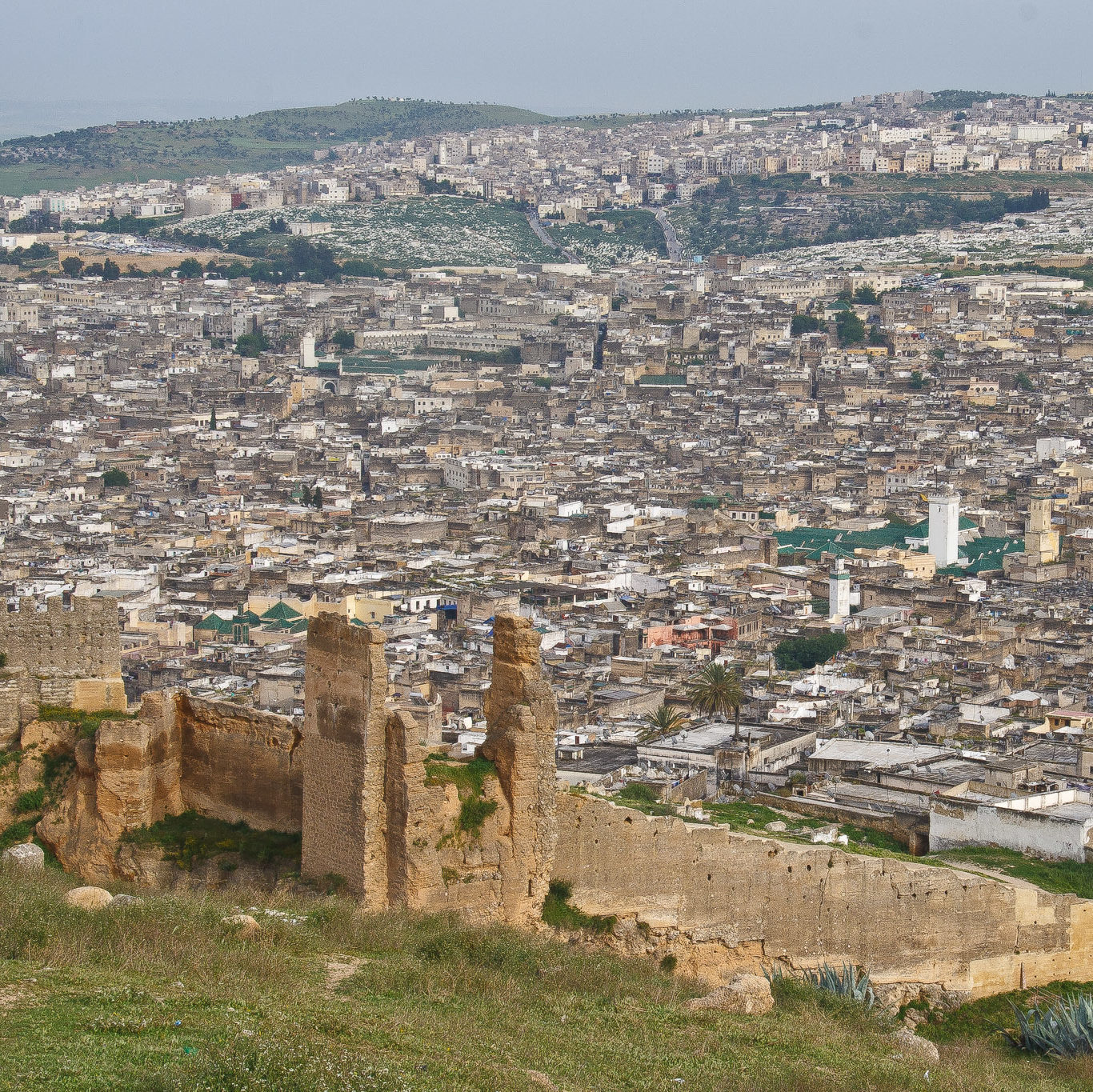

Exploring the medieval medina of your own
If you don’t get lost in the medina, did you really visit Fez at all? Discovering dead-end streets, secret gardens and vibrant souks are integral to the experience. Undertaking the wandering on your own can seem daunting, especially if you’re on a tight schedule. That’s why hiring a guide can be a good idea for some. Nonetheless, if you’re spending more than one day in the cultural capital of Morocco, you could do without one.
Color-coded signposts allow tourists to meander through the labyrinth and uncover some of its best corners. Green signs are for Palaces and Andalucian gardens, while orange ones indicate the wall and ramparts. Follow the brown indications to walk from souk to souk and see the city’s most cherished monuments. Tours centered around “knowledge,” and artisanal craft are, respectively, indicated in blue and red. Finally, purple signs are there to show you around Fes el-Jdid.
Pay attention because the signposts are often obscured by shopkeepers intent on getting you into their workshop. Navigation in Fes el-Bali is quite simple. From Bab Bou Jeloud, you’ll find two main alleys called Telaa Sghira and Telaa Kebira (meaning little and big slope). These lead gradually downhill to Al-Qarawiyyin mosque and Place R’cif. If you feel you’re lost, follow the main flow of people until you can find you’re bearing once again.
Useful tip
The Fez Medina takes roughly the shape of a bowl. If you’ve been running in circles for some time, try to go uphill.
Map of the Fez medina
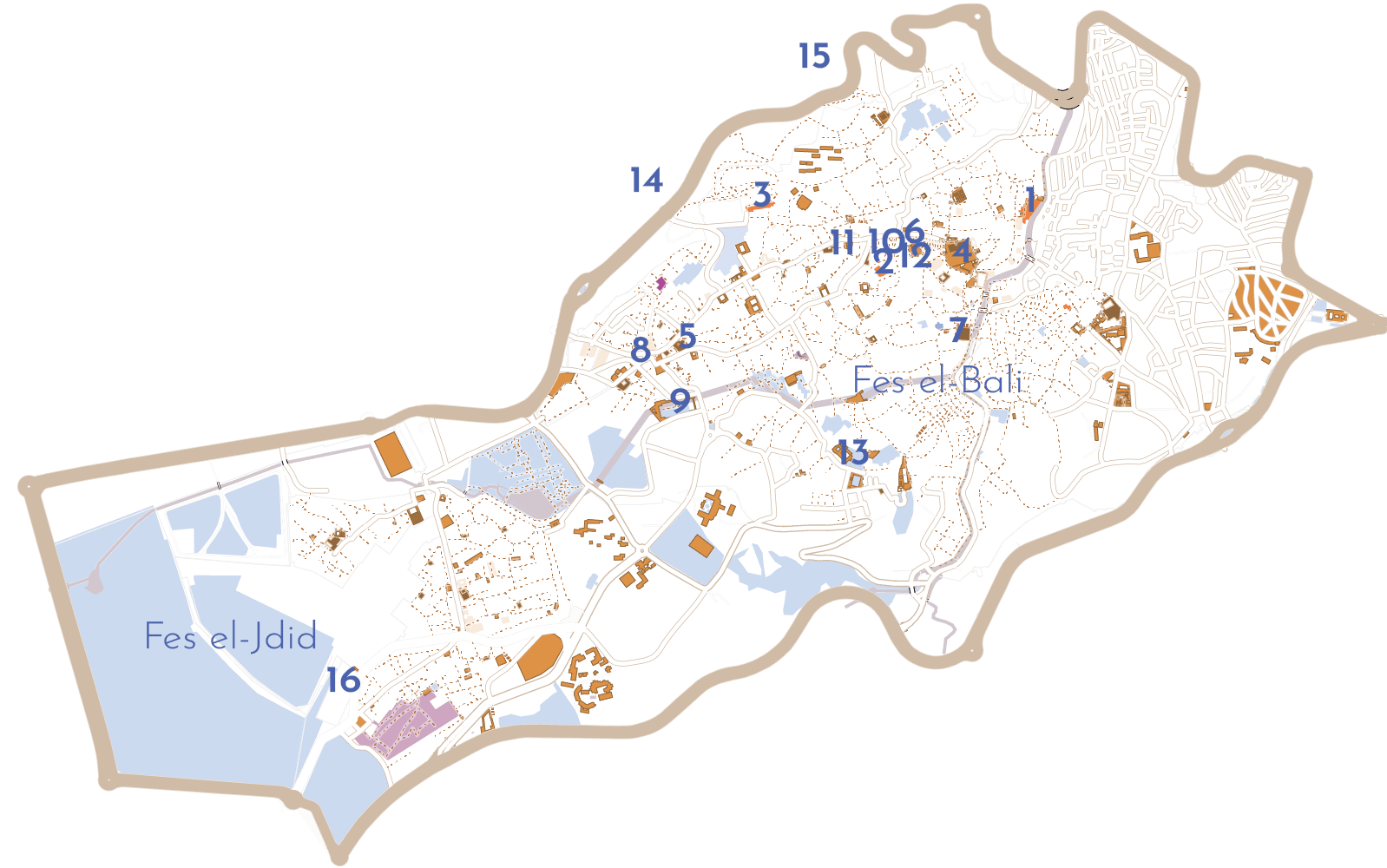
Visiting the medina
- Chouara Tannery
- Sidi Moussa Tannery
- Ain Azliten Tannery
- Al-Attarine Madrasa
- Bou Inania Madrasa and Dar al-Magana
- Souk el Henna
- Souk at R’cif Square
- Bab Bou Jeloud
- Dar Batha
- Fondouk el-Nejjarine
- Chrabliyine Mosque
- Zawiya of Moulay Idriss II
- Palais Glaoui
- Borj Nord
- Merenid Tombs
- Royal Palace
How to find a good guide in Fez?
You should expect to pay around 250 dhs for half a day (or 500 dhs for a full-day tour) with an official guide of Fez.
Rare are the guides that won’t try to make a few obligatory shopping stops. Make it clear that at the first non-desired stop at an argan or leather shop, you will curtail the tour immediately and not pay him a penny. Shopping while on your guided tour of the medina has two disadvantages:
- You might waste a lot of time going to places where your guide gets cuts and that might not even be of interest to you, making you miss the good things about the medina. For example, some will take you to the Chouara Tannery when the vats are half empty at the end of the day.
- You pay more for anything you buy since there’s a markup price for the guide bringing you to the shop
Some will ask you for an extra 50 dhs to compensate for the loss on their commissions at the workshop. Don’t let that deter you, that’s a much better deal than paying for overpriced souvenirs. Avoid guides gotten through riads and hotels. Many of those are not even official, often a relative of the owner or reception staff. Go to the tourist office instead. In fact, anyone who offers to guide you in Fez legally has to be an official guide. Otherwise, they risk being arrested as a ‘faux guide’.
When is the Best Time to Visit Fez?
The high season hits Fez in the spring and when the summer ends. September is the year’s busiest month, followed by August and October. In springtime, May is the best month to visit Northern Morocco. Avoid the city from December through February since the weather is too cold at this time of year to be enjoyable for travellers looking for a sunny getaway. November and December are notably the wettest months of the year, with around eight rainy days each.
Good hotels in Fez
| TYPE | ACCOMMODATION | RATING | PRICE |
| Riad | Dar Seffarine | 5 / 5 | From € 80 / night |
| Riad | Dar Bensouda | 5 / 5 | From € 106 / night |
| Luxury | Hotel Sahrai *In the Nouvelle Ville* | 4,5 / 5 | From € 208 / night |

